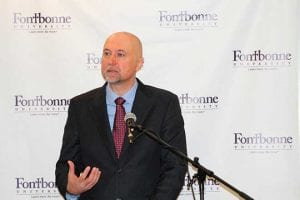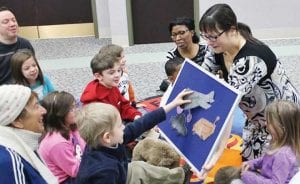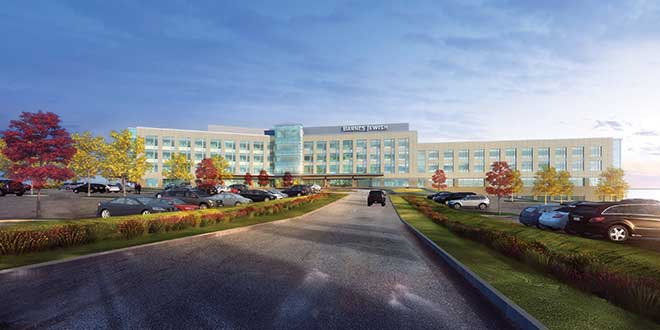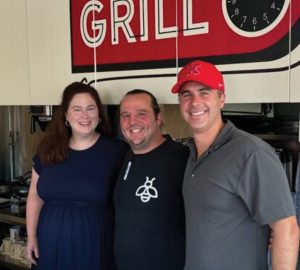creve coeur
After nearly two years of planning, the approved design of a new complex to replace the existing Barnes-Jewish West County Hospital (pictured above) is complete, and groundbreaking is anticipated for the first quarter of 2017. The new hospital calls for 64 private patient rooms, four ICU rooms and 14 operating rooms, with room for future expansion to 100 patient rooms and 16 operating rooms. An adjoining medical office building also will be constructed on the existing Creve Coeur campus. The new hospital will continue BJWCH’s focus on low acuity, short-stay surgical and medical cases. Acuity refers to the intensity of care required by a patient, and assigns nurses on a shift according to patient needs, not patient numbers.
 clayton
clayton
Award-winning documentarist Refik Hodzic has received the 2016 Civic Courage Award from the Bosnia Memory Project at Fontbonne University in Clayton. A native of Prijedor, Bosnia-Herzegovina, Hodzic is a longtime journalist with an extensive career in media and communications, including positions in Bosnian-language radio and international news outlets, as well as with the United Nations, the International Criminal Tribunal for the former Yugoslavia, and the International Center for Transitional Justice in NYC. Fontbonne’s Bosnia Memory Project preserves the stories and artifacts of the Bosnian war and genocide and hosts events to raise awareness about Bosnia-Herzegovina and the Bosnian diaspora. The project actively gathers oral histories from the local Bosnian community as part of a living archive for scholars and researchers. Over the years, the main focus of Hodzic’s journalism, film-making and outreach work has been on transitional justice issues. His work has drawn global attention to human rights and social justice in countries globally.
 ladue
ladue
Kids with an autistic spectrum disorder need an environment that does not overwhelm them with sensory stimulation, and as researchers discover more about what causes discomfort, organizations across the country are creating safer spaces. The number of children with autism spectrum disorders has nearly doubled in recent years, from 1 in 80 kids in 2010 to 1 in 45 kids in 2015. St. Louis has created special events where these children can feel more at home. To wit, this fall, the Saint Louis Zoo introduced Sensory Saturdays at The Living World. And this month, St. Louis County Library introduces a program at Ladue headquarters and South County’s Weber Road Branch: Sensory Story Time. A concept that’s met with success at libraries nationwide, the program aims to help families with children ages 3 through 9 who are on the spectrum or have multisensory needs. Children are able to enjoy a story and other fun activities in soothing surroundings. The library will use props, toys and tactile objects to offer them a variety of ways to process information. To raise the comfort level, SLCL will provide noise-canceling headphones and blue light covers to offset fluorescent lighting and loud noises. SLCL has put together a slideshow outlining planned activities, which parents say provides a visual road map to help their kids transition from one activity to the next. The program kicks off Feb. 6 at 6:30 p.m. at headquarters (1640 S. Lindbergh Blvd.) and will continue monthly on the first and third Mondays; at Weber Road (4444 Weber Road), it starts Jan. 9 and continues monthly on the second and fourth Mondays.
overland
U. City’s loss is Overland’s gain, with Operation Food Search moving a little north from a 25,000-square-foot building on Olive Boulevard to one on Lotsie Boulevard of 67,000 square feet. The former window factory, vacant for years, cost $2.27 million; renovations added another $2.5 million. OFS began a capital campaign last January to raise $7 million toward the goal, which netted a facility nearly three times larger. A comprehensive food distribution and nutrition education center means OFS can better respond to the region’s growing hunger needs, incorporating best practices for efficiencies in distribution, including advanced inventory management, increased product racking capabilities, additional truck bays, and expanded refrigeration for perishables. A new, state-of-the-art community kitchen is the perfect venue for hosting culinary and nutrition education classes to complement OFS’ community-based programs. Multipurpose spaces provide member agencies and stakeholders room to collaborate; also, a volunteer room was added. Founded in 1981, OFS helps feed more than 200,000 people on a monthly basis—one-third of them children—through a network of 330 community partners in St. Louis and 31 Missouri and Illinois counties. For every dollar donated, OFS provides $21 worth of food and nutrition services to support the area’s hungry. If that isn’t an impressive ROI, we don’t know what is.
 st. louis
st. louis
The Arch, the zoo and the World’s Fair are each part of the metro’s rich history and often included as reference points for St. Louis. Well, what about el Montículo, La Calle and El Helado? For those whose Spanish is a little rusty—these mean the mound, as in Cahokia, Illinois; the street, as in Cherokee; and ‘the ice cream’ (ice cream cones were invented here at the 1904 Fair)—they’re all included in a new, St. Louis-themed, bilingual lotería game designed as part of St. Louis Mosaic Project’s efforts to celebrate Latino culture and create a welcoming environment for Hispanics. Fashioned after the traditional Mexican lotería game (similar to bingo), this version uses iconic images from in and around the Lou. There’s a colorful picture on the front of each card and a bilingual description/explanation on the reverse side. But the ceremonial Native American mounds near Collinsville? How apropos, since some St. Louisans still think of anything east of the Mississippi River as Indian territory, uncharted wilderness. Mosaic plans to distribute free copies to area organizations, schools and churches that serve the local Hispanic community, including the International Institute, the Hispanic Chamber of Commerce, Casa de Salud and the Archdiocese of St. Louis for entertainment or education purposes. Mosaic soon will debut video testimonials featuring Latin Americans who now call St. Louis home. From students and executives to small business owners and former Cardinals catcher Brayan Peña, they share their experiences about settling into their adopted city. The videos also will be available on Mosaic’s website and on YouTube. Just launched in 2012, Mosaic aims to ensure that St. Louis is a welcoming major metropolitan area for immigration and ‘to promote regional prosperity through immigration and innovation.’








